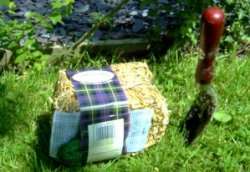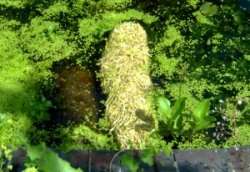This is a feature summary. If you would like to read the full text, click here.Combating algae with barley straw
Algae, such as blanket weed, can often take over a garden pond, but there is something you can do about it.
Why does algae take hold?
Some algae is always present in ponds. If it starts to take over, it's normally because there are too many nutrients in the water. This might be because tap water is used to top up the pond or food is being thrown in for fish.
Combating algae
We must remember that algae are not all bad - a certain amount is vital for a healthy pond, providing food for many animals. The best long term solution to controlling algae is to sort out the nutrient levels in your pond, e.g. by topping up with rainwater and being more careful about feeding fish, but other techniques have their place too.
The story goes that a farmer who accidentally dropped barley straw into a pond and left it there, noticed a dramatic reduction in the amount of algae. Scientists did experiments and found evidence that the barley straw causes chemical changes in the water which inhibit algae, though these findings have not been proved beyond doubt.
How to use barley straw
Small barley straw bales for garden ponds are available in most garden centres. They consist of a quantity of barley straw and a plastic net into which you put it before submerging it in your pond. The number of bales you need to use at once depends on the size of your pond. Normally you need to change the bales twice a year.
The barley straw bale
These pictures show a barley straw bale that I put into my pond to help control algae.
 | | The packaged barley straw bale which I bought from a local garden centre. |
|  | | The bale is put in a fine-meshed bag (supplied with it) and then placed in the pond (tethered to the side). |
|
The story in my pond
Shortly after I created my pond there was a 'algal bloom' (probably because I filled the pond with tap water) and within a few months I had quite a lot of blanket weed. I put a 'barley straw' bale into the pond in the autumn.
Not much happened over the winter, but in early spring there was a sudden and dramatic reduction in algae and blanket weed. This might have been thanks to the barley straw, but there could also be another explanation: just before the algae began to decline, I put a log into the pond which used to be submerged in my old pond. There have been reports from elsewhere that branches can have a similar effect to barley straw.
The bottom line is that I don't know if it was the barley straw or the log or something else which brought the algae under control in my own pond. But if you have an algae problem, simple measures like these are cheap and easy enough to try and you never know, the results might be equally impressive.
| First published June 2003. Last revised January 2004. |
|
Copyright Richard Burkmar 2003. Permission is hereby granted for anyone to use this article for non-commercial purposes which are of benefit to the natural environment as long the original author is credited. School pupils, students, teachers and educators are invited to use the article freely. Use for commercial purposes is prohibited unless permission is obtained from the copyright holder. |
This is a feature summary. If you would like to read the full text, click here.